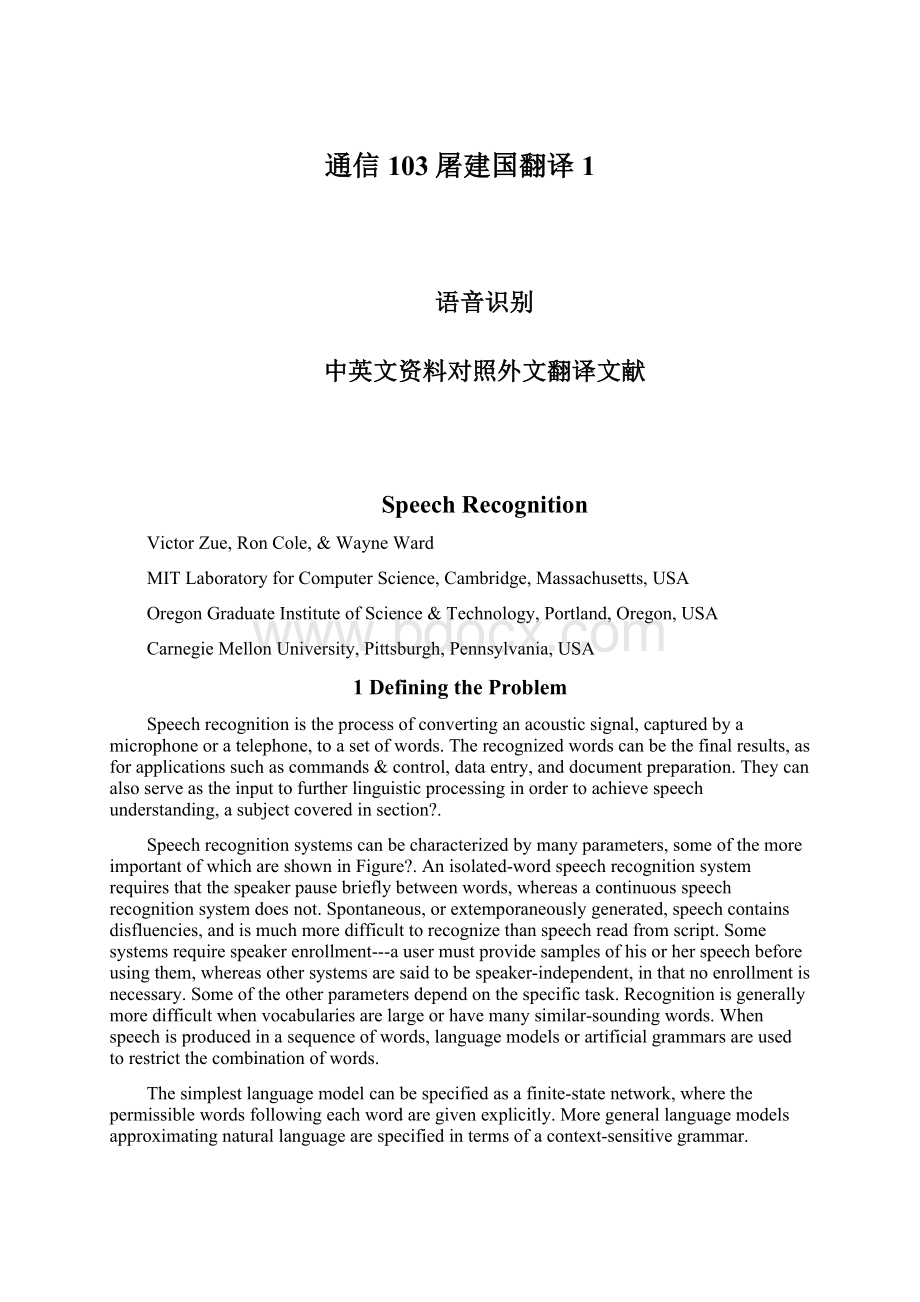通信103屠建国翻译1Word下载.docx
《通信103屠建国翻译1Word下载.docx》由会员分享,可在线阅读,更多相关《通信103屠建国翻译1Word下载.docx(12页珍藏版)》请在冰豆网上搜索。

MITLaboratoryforComputerScience,Cambridge,Massachusetts,USA
OregonGraduateInstituteofScience&
Technology,Portland,Oregon,USA
CarnegieMellonUniversity,Pittsburgh,Pennsylvania,USA
1DefiningtheProblem
Speechrecognitionistheprocessofconvertinganacousticsignal,capturedbyamicrophoneoratelephone,toasetofwords.Therecognizedwordscanbethefinalresults,asforapplicationssuchascommands&
control,dataentry,anddocumentpreparation.Theycanalsoserveastheinputtofurtherlinguisticprocessinginordertoachievespeechunderstanding,asubjectcoveredinsection?
.
Speechrecognitionsystemscanbecharacterizedbymanyparameters,someofthemoreimportantofwhichareshowninFigure?
.Anisolated-wordspeechrecognitionsystemrequiresthatthespeakerpausebrieflybetweenwords,whereasacontinuousspeechrecognitionsystemdoesnot.Spontaneous,orextemporaneouslygenerated,speechcontainsdisfluencies,andismuchmoredifficulttorecognizethanspeechreadfromscript.Somesystemsrequirespeakerenrollment---ausermustprovidesamplesofhisorherspeechbeforeusingthem,whereasothersystemsaresaidtobespeaker-independent,inthatnoenrollmentisnecessary.Someoftheotherparametersdependonthespecifictask.Recognitionisgenerallymoredifficultwhenvocabulariesarelargeorhavemanysimilar-soundingwords.Whenspeechisproducedinasequenceofwords,languagemodelsorartificialgrammarsareusedtorestrictthecombinationofwords.
Thesimplestlanguagemodelcanbespecifiedasafinite-statenetwork,wherethepermissiblewordsfollowingeachwordaregivenexplicitly.Moregenerallanguagemodelsapproximatingnaturallanguagearespecifiedintermsofacontext-sensitivegrammar.
Onepopularmeasureofthedifficultyofthetask,combiningthevocabularysizeandthelanguagemodel,isperplexity,looselydefinedasthegeometricmeanofthenumberofwordsthatcanfollowawordafterthelanguagemodelhasbeenapplied(seesection?
foradiscussionoflanguagemodelingingeneralandperplexityinparticular).Finally,therearesomeexternalparametersthatcanaffectspeechrecognitionsystemperformance,includingthecharacteristicsoftheenvironmentalnoiseandthetypeandtheplacementofthemicrophone.
Parameters
Range
SpeakingMode
Isolatedwordstocontinuousspeech
SpeakingStyle
Readspeechtospontaneousspeech
Enrollment
Speaker-dependenttoSpeaker-independent
Vocabulary
Small(<
20words)tolarge(>
20,000words)
LanguageModel
Finite-statetocontext-sensitive
Perplexity
10)tolarge(>
100)
SNR
High(>
30dB)tolaw(<
10dB)
Transducer
Voice-cancellingmicrophonetotelephone
Table:
Typicalparametersusedtocharacterizethecapabilityofspeechrecognitionsystems
Speechrecognitionisadifficultproblem,largelybecauseofthemanysourcesofvariabilityassociatedwiththesignal.First,theacousticrealizationsofphonemes,thesmallestsoundunitsofwhichwordsarecomposed,arehighlydependentonthecontextinwhichtheyappear.Thesephoneticvariabilitiesareexemplifiedbytheacousticdifferencesofthephoneme,Atwordboundaries,contextualvariationscanbequitedramatic---makinggasshortagesoundlikegashshortageinAmericanEnglish,anddevoandaresoundlikedevandareinItalian.
Second,acousticvariabilitiescanresultfromchangesintheenvironmentaswellasinthepositionandcharacteristicsofthetransducer.Third,within-speakervariabilitiescanresultfromchangesinthespeaker'
sphysicalandemotionalstate,speakingrate,orvoicequality.Finally,differencesinsociolinguisticbackground,dialect,andvocaltractsizeandshapecancontributetoacross-speakervariabilities.
Figureshowsthemajorcomponentsofatypicalspeechrecognitionsystem.Thedigitizedspeechsignalisfirsttransformedintoasetofusefulmeasurementsorfeaturesatafixedrate,typicallyonceevery10--20msec(seesectionsand11.3forsignalrepresentationanddigitalsignalprocessing,respectively).Thesemeasurementsarethenusedtosearchforthemostlikelywordcandidate,makinguseofconstraintsimposedbytheacoustic,lexical,andlanguagemodels.Throughoutthisprocess,trainingdataareusedtodeterminethevaluesofthemodelparameters.
Figure:
Componentsofatypicalspeechrecognitionsystem.
Speechrecognitionsystemsattempttomodelthesourcesofvariabilitydescribedaboveinseveralways.Atthelevelofsignalrepresentation,researchershavedevelopedrepresentationsthatemphasizeperceptuallyimportantspeaker-independentfeaturesofthesignal,andde-emphasizespeaker-dependentcharacteristics.Attheacousticphoneticlevel,speakervariabilityistypicallymodeledusingstatisticaltechniquesappliedtolargeamountsofdata.Speakeradaptationalgorithmshavealsobeendevelopedthatadaptspeaker-independentacousticmodelstothoseofthecurrentspeakerduringsystemuse,(seesection).Effectsoflinguisticcontextattheacousticphoneticlevelaretypicallyhandledbytrainingseparatemodelsforphonemesindifferentcontexts;
thisiscalledcontextdependentacousticmodeling.
Wordlevelvariabilitycanbehandledbyallowingalternatepronunciationsofwordsinrepresentationsknownaspronunciationnetworks.Commonalternatepronunciationsofwords,aswellaseffectsofdialectandaccentarehandledbyallowingsearchalgorithmstofindalternatepathsofphonemesthroughthesenetworks.Statisticallanguagemodels,basedonestimatesofthefrequencyofoccurrenceofwordsequences,areoftenusedtoguidethesearchthroughthemostprobablesequenceofwords.
ThedominantrecognitionparadigminthepastfifteenyearsisknownashiddenMarkovmodels(HMM).AnHMMisadoublystochasticmodel,inwhichthegenerationoftheunderlyingphonemestringandtheframe-by-frame,surfaceacousticrealizationsarebothrepresentedprobabilisticallyasMarkovprocesses,asdiscussedinsections,and11.2.Neuralnetworkshavealsobeenusedtoestimatetheframebasedscores;
thesescoresarethenintegratedintoHMM-basedsystemarchitectures,inwhathascometobeknownashybridsystems,asdescribedinsection11.5.
Aninterestingfeatureofframe-basedHMMsystemsisthatspeechsegmentsareidentifiedduringthesearchprocess,ratherthanexplicitly.Analternateapproachistofirstidentifyspeechsegments,thenclassifythesegmentsandusethesegmentscorestorecognizewords.Thisapproachhasproducedcompetitiverecognitionperformanceinseveraltasks.
2StateoftheArt
Commentsaboutthestate-of-the-artneedtobemadeinthecontextofspecificapplicationswhichreflecttheconstraintsonthetask.Moreover,differenttechnologiesaresometimesappropriatefordifferenttasks.Forexample,whenthevocabularyissmall,theentirewordcanbemodeledasasingleunit.Suchanapproachisnotpracticalforlargevocabularies,wherewordmodelsmustbebuiltupfromsubwordunits.
PerformanceofspeechrecognitionsystemsistypicallydescribedintermsofworderrorrateE,definedas:
whereNisthetotalnumberofwordsinthetestset,andS,I,andDarethetotalnumberofsubstitutions,insertions,anddeletions,respectively.
Thepastdecadehaswitnessedsignificantprogressinspeechrecognitiontechnology.Worderrorratescontinuetodropbyafactorof2everytwoyears.Substantialprogresshasbeenmadeinthebasictechnology,leadingtotheloweringofbarrierstospeakerindependence,continuousspeech,andlargevocabularies.Thereareseveralfactorsthathavecontributedtothisrapidprogress.First,thereisthecomingofageoftheHMM.HMMispowerfulinthat,withtheavailabilityoftrainingdata,theparametersofthemodelcanbetrainedautomaticallytogiveoptimalperformance.
Second,muchefforthasgoneintothedevelopmentoflargespeechcorporaforsystemdevelopment,training,andtesting.Someofthesecorporaaredesignedforacousticphoneticresearch,whileothersarehighlytaskspecific.Nowadays,itisnotuncommontohavetensofthousandsofsentencesavailableforsystemtrainingandtesting.Thesecorporapermitresearcherstoquantifytheacousticcuesimportantforphoneticcontrastsandtodetermineparametersoftherecognizersinastatisticallymeaningfulway.Whilemanyofthesecorpora(e.g.,TIMIT,RM,ATIS,andWSJ;
seesection12.3)wereoriginallycollectedunderthesponsorshipoftheU.S.DefenseAdvancedResearchProjectsAgency(ARPA)tospurhumanlanguagetechnologydevelopmentamongitscontractors,theyhaveneverthelessgainedworld-wideacceptance(e.g.,inCanada,France,Germany,Japan,andtheU.K.)asstandardsonwhichtoevaluatespeechrecognition.
Third,progresshasbeenbroughtaboutbytheestablishmentofstandardsforperformanceevaluation.Onlyadecadeago,researcherstrainedandtestedtheirsystemsusinglocallycollecteddata,andhadnotbeenverycarefulindelineatingtrainingandtestingsets.Asaresult,itwasverydifficulttocompareperformanceacrosssystems,andasystem'
sperformancetypicallydegradedwhenitwaspresentedwithpreviouslyunseendata.Therecentavailabilityofalargebodyofdatainthepublicdomain,coupledwiththespecificationofevaluationstandards,hasresultedinuniformdocumentationoftestresults,thuscontributingtogreaterreliabilityinmonitoringprogress(corpusdevelopmentactivitiesandevaluationmethodologiesaresummarizedinchapters12and13respectively).
Finally,advancesincomputertechnologyhavealsoindirectlyinfluencedourprogress.Theavailabilityoffastcomputerswithinexpensivemassstorage